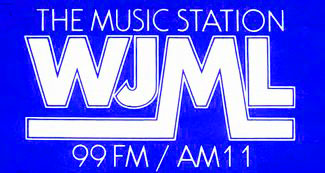Westward Ho
Tulare California was the first stop after WJML. Tulare is pronounced tuu-LAIR-ee and is in the heart of California's Central Valley between Fresno and Bakersfield. It's a farming area near the Sierra Nevada Mountains making for an imposing view.
The station, KCOK at the time, was a 5,000 watt day time and 1,000 watt night time operation paired with KJUG-FM. This was the first time I'd ever seen an automated radio operation. The billing and program logs were stored on 8 inch floppy discs, and the FM Country Format consisted of a syndicated program delivered on 12 inch tape reels. Tones embedded in the program triggered the local commercial breaks. Commercials were played from Fidelipac cartridges housed in carousel players that were programmed using what looked like a peg board with pegs, somewhat like golf tees inserted in the matrix. It was a separate staff that operated the automation. The AM side was 'live'. We selected our music out of a cardboard box sitting next to to the audio console. There were no hot clocks, station jingles or contests. It was a pretty low key style but my JML training kicked in and the program director never approached me on my delivery style.
My stay at KCOK was brief, from late October until February. I was approached by Garry Brill who was building a station on the Central Coast near San Luis Obispo and I was eager to leave. The new station KIQO-FM was the first for Atascadero and it presented a new challenge for me because it was going to be automated. Cetec was providing the automation, studio consoles, turntables, transmitter and everything in-between. They proudly heralded that we were their first Cetec fully equipped station. As Chief Engineer I wrote the programming software (a first for me) and performed equipment maintenance and repairs. As Music Director I picked the music that got recorded on tape for playback. I was also the morning DJ operating live with the automation assisting in playing commercials and music. After the live assist portion I cut voice tracks for the remainder of the morning and all the other shifts were performed using voice tracks by the rest of the staff. The only air check I ever recorded was the initial sign on. After a little over a year I got a job offer from one of managers at TV station KCOY in Santa Maria. Bob Burris was leaving to take over a station, KKIQ in Livermore, California, just outside the San Francisco Bay Area. Thinking this could lead to bigger opportunities I took the job.
There were many facets to this new offer. Burris wanted someone experienced in automation because he intended to automate KKIQ. He also needed a chief operator to install the system and repair and maintain the rest of the station, and as a capper he liked my air work and I took over the morning show. As the months went by I installed the automation (which really didn't make me too popular with the rest of the air staff) and for various reasons I decided to return to KIQO.
KIQO became my last gig as a DJ. After several months I left to taka a job as an assistant engineer at KPRL in Paso Robles and shortly after that decided to do freelance chief operator/engineer work for 4 stations KZOZ, KKAL, KUHL and KXFM, plus KIQO wanted me to do some of their maintenance as well. The following three months became very hectic. I moved the KZOZ studios from San Luis Obispo to Arroyo Grande. The FCC and FAA helped me find an RF spur from KZOZ in the control tower frequency at the San Luis Obispo airport. KXFM suffered a lightning strike that damaged the transmitter power supply. I built a satellite dish for KUHL to get news feeds from the network. There were numerous emergency calls with the pager going off day and night. Eventually the KZOZ, KKAL, KUHL and KXFM contract fell apart as one group felt they weren't getting equal time and I was happy to wash my hands of what became too much work for too little pay. I left broadcasting and ventured to a civil service position in Oceanography at Monterey and then a communications technician job at Vandenberg Air Force Base near Lompoc California. Click the link below for the California airchecks.
